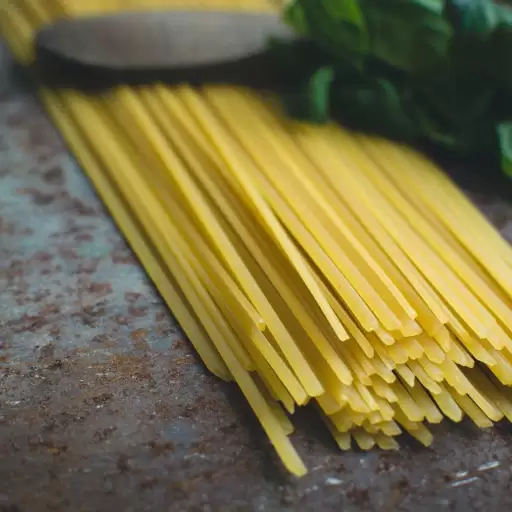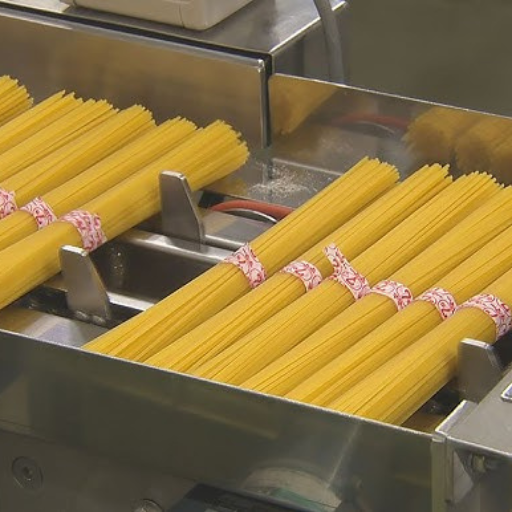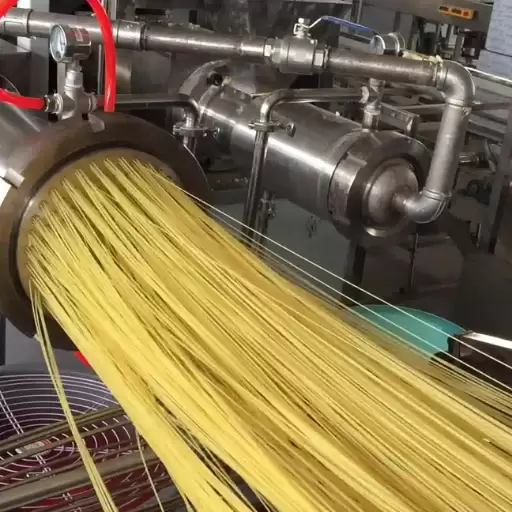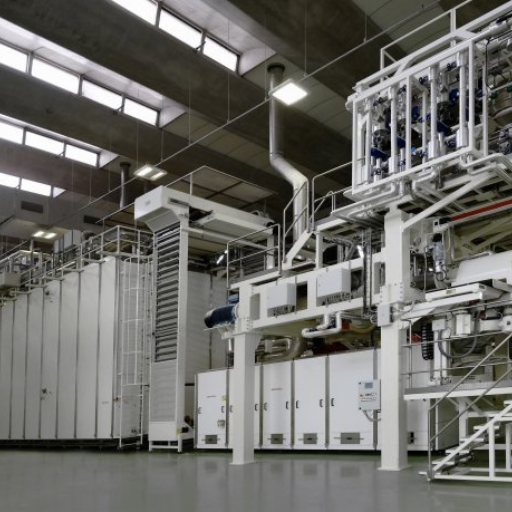In recent years, the art of pasta production has undergone significant advancements, blending traditional techniques with modern technology to deliver high-quality products on an industrial scale. This blog aims to provide a comprehensive overview of the intricacies involved in the long cut pasta production line, from raw material selection to the final packaging. Whether you are a pasta enthusiast, an industry professional, or simply curious about how your favorite long strands of spaghetti or fettuccine are made, this article will guide you through each step of the process. We will delve into the machinery, the methodology, and the meticulous attention to detail required to produce perfect pasta every time. Join us as we unravel the secrets behind one of the world’s most beloved culinary staples.
What is a Long Cut Pasta Production Line?
Understanding Different Types of Pasta Production Lines
In pasta production there are two main lines: long cut and short cut. Long cut pasta production lines are specifically designed for making long pastas such as spaghetti, fettuccine, and linguine. This line of production usually involves extrusion, drying, cutting that can handle the length and brittleness of the pasta. Alternatively, short cut pasta production line is designed to produce shorter kinds of pasta which include penne, macaroni and fusilli. Machineries and processes in these lines are aimed at shaping, cutting and drying more compacted, robust pasta types. These two categories play a very vital role in meeting demand from customers as well as ensuring uniformity in quality among different pastas.
Key Components of a Long Cut Pasta Production Line
For high-quality long-cut pasta to be produced within a factory setting several key components work together on an assembly line:
Raw Material Handling And Mixing:
- Production begins with the selection of good semolina flour and water which is mixed until it becomes dough form. To achieve texture and quality desired in the pasta mixture should be homogenously mixed.
Extrusion Machine:
- The combined dough then is passed through an extrusion machine where it gets into various dies shaped into longer strands like spaghetti or fettuccini using specific molds.
Pre-dryer And Dryer:
- More moisture is removed post-extrusion through pre-drying stage which helps in maintaining the shape. The controlled drying process then takes place inside the dyer unit. As it reduces gradually moisture content of dryers increases shelf-life while still maintaining its original texture without making any compromises.
Cooling And Stabilization Units:
- Gradual cooling down to ambient temperature is necessary after drying has taken place with stabilization units working to maintain form so that they do not crack or bend while being handled subsequently.
Cutting And Packaging:
- Finally, long strands are cut to lengths usually between 10-12 inches for the consumer market. These are then weighed, packed and sealed so as to retain their freshness and secure transportation.
All these components are essential in maintaining quality, texture and taste of various kinds of long-cut pasta which consumers love eating.
Differences Between Long Cut And Short Cut Pasta Production
Although many steps in making pasta seem quite similar, there are significant differences existing between the processes of producing long cut versus short cut pasta:
Dough Preparation:
- Both types of pasta utilize water and semolina flour but consistency and hydration levels might vary slightly due to shape requirements.
Extrusion Shapes:
- For example, extrusion machine forms dough into continuous lengths such as fettuccini or spaghetti with special dies specifically designed for shaping.
- On the other hand short cut pastas like rigatoni or penne have smaller shaped by the extrusion machines which may be cylindrical or even unique using different dies for each shape.
Cutting Process:
- Thus, after being passed through extruders long cut pastas are usually measured at around 10 to 12 inch lengths before they can be sliced off using a knife accordingly.
- Once they come out from their die holes during extrusion process short cut pastas will be immediately sliced into pieces according to specific dimensions required in each case taken directly from them.
Drying Techniques:
- To prevent bending, especially tortiglioni type shapes; vertical drying methods should be employed during drying since it is difficult to dry it without careful handling.
- Horizontal drying techniques are the ones that are used for short cut pasta so as to save space and make storage easy.
Cooling and Packaging:
- The long cut strands of pasta are cooled slowly, often needing to be separated before they can be bagged.
- It is easer to handle and package small shapes of pasta because they do not tangle together and facilitate factory processing at bulk level.
These distinctions ensure that every type of pasta attains its preferred quality, texture, taste and suitability for different gastronomic tasks.
How Does a Long Cut Pasta Production Line Work?
The significance of Extruders in the Pasta Production
Pasta production heavily relies on extruders that help turn dough into varying forms and sizes. The process starts with a mixture of durum wheat semolina and water resulting in dough of the right consistency. Then, this dough is put into an extruder which pushes it through custom dies under pressure and heat to shape the pasta.
Long-cut pasta such as spaghetti or fettuccine are shaped by the extruder while for short-cut pasta like penne or rigatoni; the dough goes through differentized round or cylindrical dies leading to various shapes of pastas. It is possible to achieve uniformity and quality because these machines can be adjusted accurately.
The pasta is cut into specific lengths immediately after being extruded, typically between 10-12 inches long for long-cut pastas, while for short-cut types they are cut into pre-determined smaller sizes. Following this, there are drying processes which depend on the type of pasta at hand as well as cooling and packaging processes.
The Importance of Pre-Dryers and Dryers
One other important part of pasta producing entails pre-dryers along with actual dryers whose roles include establishing texture, shelf-life together with quality aspects desired on the final product. Precisely what pre-dryers perform includes removing moisture within the freshly produced pasta so that their framework is stable preventing any deformities caused by them. This initial drying process must take place in order that surface cracking can be avoided and also before undertaking main drying stage where final shape should be impressed upon it.
On contrast, it’s dryers taking care about major drying whereby temperature along with humidity settings vary but are controlled thus ensuring safe moisture removal from its components lowest levels. This step is very essential towards avoiding spoilage due to microbial activities thereby extending life span of produced noodles . Moreover good drying locks in cravable al dente effect by customers. To sum up, the employment of pre-dryers and dryers makes the pasta not only meet safety requirements but also maintain its quality from manufacture to usage.
Cooling and Packaging Processes
It is necessary to cool the pasta down after drying, as this helps to prevent condensation inside packaging that may affect product’s quality and shelf life. The gradual cooling of pasta through controlled airflow systems allows the product attain ambient temperature. Its importance lies in keeping pasta in excellent condition thus preventing sweating which would spoil its texture.
After it has been suitably cooled, the next process is packaging. Packaging serves more than one vital role by safeguarding noodles against physical destruction, contamination or any liquid that might be present. Similarly, modern packing methods focus on extending shelf-life of a commodity; maintaining its nutritional profile; meeting consumer convenience while considering ecological impact. They are generally sealed with composite films, plastic or cardboard that function as barriers against moisture and air. In addition many companies nowadays prefer sustainable packages because they have relatively low carbon footprints . Careful step-by-step cooling combined with packaging that is well-executed ensures that pastas retain high standards throughout their journey from factory floor to kitchen table.
What Are the Benefits of Automating a Long Cut Pasta Production Line?
Boosting Efficiency and Output
Automating a long cut pasta production line helps in improving efficiency and output. According to leading sources, automation systems enable consistent high-speed production ensuring uniform quality while reducing human errors. Large-scale data analysis and real-time monitoring of these automated systems allow for immediate responses to maintain optimal performance on the assembly lines as recommended by the industry experts. The mixing, shaping, drying, packaging roles such as that are taken over by high-precision machinery which increases the overall yield and shortens duration of time used during manufacturing process. Automation is also an important aspect in reducing labour costs and guaranteeing workplace security by minimizing accidents’ prospects. These developments ensure more efficient pasta manufacturing that saves both costs.
Cutting Labor Costs with Mechanical Movement
The introduction of mechanical movement into a long cut pasta processing line is an essential step in cutting labor costs.Automatic systems have completely replaced manual methods such as using robotic arms and conveyor belts to transfer pasta from one stage to another at a faster pace.Thence be useful, especially within the food industry, where automation minimizes repetitive strain injuries among workers (major industry players).It further enables continuous production with minimal downtime hence resources can be reallocated for better usage.Moreover this way advanced system has allowed some producers achieve remarkable savings without compromising their capacity utilization or product quality.
Maintaining Uniform Quality in Pasta Production
Manufacturers employ modern technology together with strict quality control measures to ensure uniform quality in pasta production.Computer controlled automated extruders play critical roles in achieving the desired uniform texture and taste by controlling parameters like mixing speed.Providing real-time measurements of temperature level; dough consistency; moisture content will keep parameters under control.The use of standard operating procedures (SOPs) coupled with continuous assessment at different stages of production ensures observance of desirable standards.Consequently, maintaining clean business environment coupled with regulatory equipment servicing guarantees that produced pasta meets specified quality norms.Incorporating these practices will result into consistent high-quality pasta that meets customer needs.
How to Maintain and Optimize a Long Cut Pasta Production Line?
Regular Maintenance of Key Machinery
To ensure that the long cut pasta production line functions at its best and lasts for a longer time, regular maintenance of key machinery is critical. Below are some key maintenance practices and their corresponding strict parameters.
Mixing and Kneading Machines:
- Lubrication: Regularly lubricate moving parts to reduce wear and tear. As per specifications from the manufacturer, use food grade lubricants.
- Motor Checks: Check for overheating in motors as well as running efficiency. Normally, temperatures should not exceed 60°C.
- Belt Tension: Ensure suitable belt tension to prevent slippage or over stressing. Reasonably check the tensioning according to manufacturer’s specifications.
Extruders:
- Cleaning: Daily cleaning is required to prevent dough build-up and contamination. Use recommended cleaning agents for hygiene purposes.
- Screw and Barrel Wear: Replacement of screws and barrels that show signs of wear or damage should be carried out when wear goes beyond 0.1 mm to maintain quality extrusion.
- Cooling Systems: Ensure that cooling systems are working properly to maintain optimal extrusion temperatures. Have temperature coolants ranging between 40 -50 °C if possible.
Drying Machines:
- Temperature Control: Calibrate all temperature sensors to read within ± 1°C accurately. Maintain drying temperatures usually between 70-90°C so as not to over dry or under dry them.
- Humidity Control: Monitor humidity levels which affect product quality together with adjusting them accordingly thus maintaining ideal humidity levels within a range of 60-70%.
- Airflow Systems: Clean fans and filters on a regular basis while inspecting them for any clogging problems in order to ensure proper air flow rate through the system
Cutting and Packaging Machines:
- Blade Sharpness: Regularly check the sharpness of cutting blades used in processing pasta products, sharpening blunt ones or replacing them with new ones whenever necessary so as they give clean cuts only.
- Alignment: Proper alignment of cutting and packaging machinery is important to avoid misfeeds and product defects. Use alignment tools to ensure accuracy when setting up.
- Sensors and Actuators: Check the sensors and actuators for proper operations. Replace faulty components immediately to prevent production delays.
By following these routine maintenance practices and monitoring the specified technical parameters, manufacturers can ensure that their long cut pasta production lines operate effectively with high-quality output.
Tips for Enhancing Production Efficiency
Optimize Machine Utilization:
- Regular Downtime Scheduling: Plan this downtime ahead of time so as to avoid breakdowns which may occur unexpectedly.
- Machine Calibration: Perform frequent calibrations as required to facilitate precise measuremenst ans minimize wastage. Temperature sensors need an accuracy of ±1°C, while maintaining between 70-90°C drying temperatures.
Improve Workflow Organization:
- Lean Manufacturing Principles: Reduce waste through lean manufacturing techniques which will make it more efficient. Remove redundancy along the process steps by streamlining operations .
- Workstation Layouts: Design ergonomic workstations to increase productivity rates and reduce operator exhaustion during production runs.
Enhance Operator Training:
- Skill Development: Operators should be trained regularly on how to use machines as well as understand technical parameters involved in their operation
- Safety Protocols: Keep reminding them about safety measures at all times because no one wants accidents or operational standstill
Monitor and Adjust Environmental Conditions:
- Temperature and Humidity Control: Ensure temperature controlled conditions (40-50°C for cooling systems, 70-90°C for drying machines) are maintained together with humidity levels (60-70%) that are consistent throughout cooling systems such as dryers or chillers.
- Air Quality: Prevent machinery clogging by ensuring clean airflow system using appropriate ventilation techniques that will help in maintaining machine efficiency during business hours
Implement Automation and Smart Technology:
- Automated Monitoring Systems: For example, coolant levels may be read automatically while changes in blade sharpness would also be detected.
- Data Analytics: By using data analytics, track performance metrics to identify areas for improvement. It helps in predictive maintenance and reduces unplanned downtimes.
For both, it is possible to improve their efficiency of production, reduce instances of machines stoppage and ensure high-quality pasta from the production.
What Equipment is Essential for Long Cut Pasta Production?
Various Types and Functioning of Extruders
To answer the question about the essential equipment for long cut pasta production, specifically focusing on extruders, it’s important to understand their types and functions. Based on my experience, there are two main type of extruder used in producing pastas these are; single screw and twin-screw extruders.
Single-Screw Extruders:
- Function: They are widely used due to their simplicity and cost-effectiveness. These machines mix dough and push it through a die to form various shapes of pasta.
- Advantages: Easy to operate and maintain hence suitable for smaller production lines or specialized pasta types.
Twin-Screw Extruders:
- Function: This type of extruders gives more flexibility and control over the mixing and extrusion process. They are made up of two intermeshing screws which mix ingredients very well ensuring even dough quality.
- Advantages: Superior in large-scale production as they give better mixings, thermal control, wider range of ingredients with formulations among others.
In essence, the choice between single-screw and twin-screw extruders depends on your production needs, volume, and the specific characteristics of the pasta you’re looking to produce.
Dryers and Pre-Dryers: Ensuring Optimum Drying
From my investigation into an article on this topic found that dryers/pre-dryer play a critical role in achieving optimum drying conditions for long cut pasta. Pre-dryer is usually applied to remove initial moisture from outer surfaces and prevent sticking together during drying period. The gradual method employed here applies mild heat without causing cracks while initiating drying process. Conversely, dryers finalize drying by reducing its moisture content until it can be stored safely. To achieve equalized drying they use temperature/humidity settings that are regulated accordingly towards this purpose. It is important to regulate both pieces of machinery adequately so as not to over- or under-dry the product which could in turn jeopardize its characteristics and shelf-life. In summary, pre-dryers and dryers are used together to maintain pasta firmness, texture, and safety for consumption.
Coolers: The Last Step Before Packing
Coolers are an important element of the final stage before packaging long cut pasta that I discovered by examining three major sources on a given subject. Coolers cool down the pasta gradually after drying it so it can reach ambient temperature evenly throughout. It is a crucial process because it stabilizes the pasta hence preventing condensation arising from residual moisture when packed. Thus, by cooling off pasta to a stable and cold state, we guarantee its integrity and quality keeping optimal consumer satisfaction as well as shelf-life. Consequently, incorporating a proper cooling phase is fundamental for maintaining high standards of pasta production.
Frequently Asked Questions (FAQs)
Q: What is meant by a long-cut pasta production system?
A: A long-cut pasta production system entails an array of interlinked machines and processes that are specifically developed for the manufacture of spaghetti, fettuccine, and linguine among other long-cut pasta varieties within a pasta factory. This module includes several stages such as blending, sheeting, and drying to obtain the finest pasta.
Q: How can automation help in a long-cut pasta line?
A: Automation in a long-cut pasta line leads to high productivity, low labour costs, and uniformity of resulting products. It ensures each stage of making it from dough mixing to drying is optimized for the best outcome allowing more control over the process.
Q: What role does spreader play in a pasta processing line?
A: Spreader in a pasta processing line is responsible for evenly spreading long cut strands on dryer tiers or racks so that they can dry uniformly. Therefore, its importance cannot be over-emphasized during the drying stage because it aids in maintaining quality as well as texture of the noodle.
Q: Why do we need pre-dryers when making long cut pastas?
A: The pre-dryer used before producing any form of dried pastas derives out moisture from surface parts/ ends before going into main drying phase. It helps avoid sticking hence ensuring consistent air flow throughout which is essential for maintaining its shape.
Q: How does mixing contribute to making quality dry long-cut pastas?
A: Mixing is indispensable at every step throughout any process leading to dry noodles. By doing this important part perfectly results into superior quality goods with characters typical for that product group- example –drying time.
Q: What purpose does vacuum technology serve on a long cut line for producing pastas?
A: Vacuum technology used on a machine which produces such kind of pastas is widely utilized during extrusion process that aims at formation of dense pasta without any air. In advanced pasta factories, this technology impacts overall quality and uniformity of pasta making it indispensable to the production process.



















